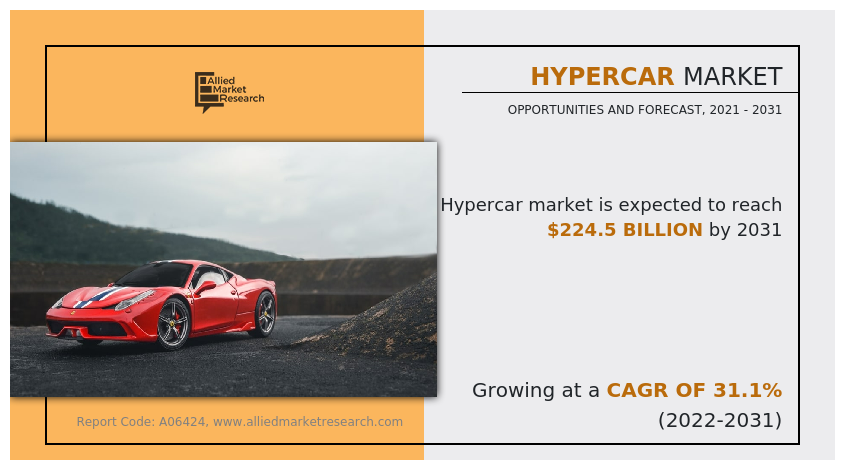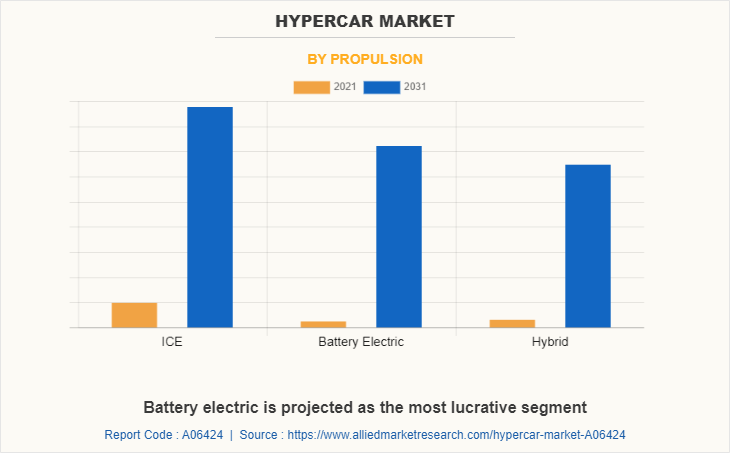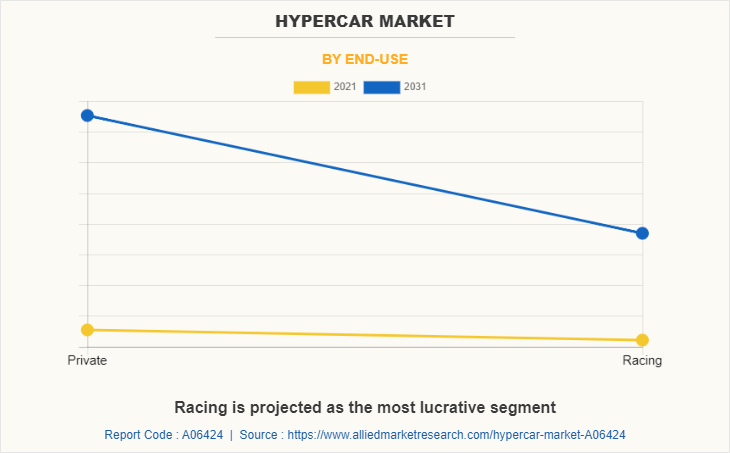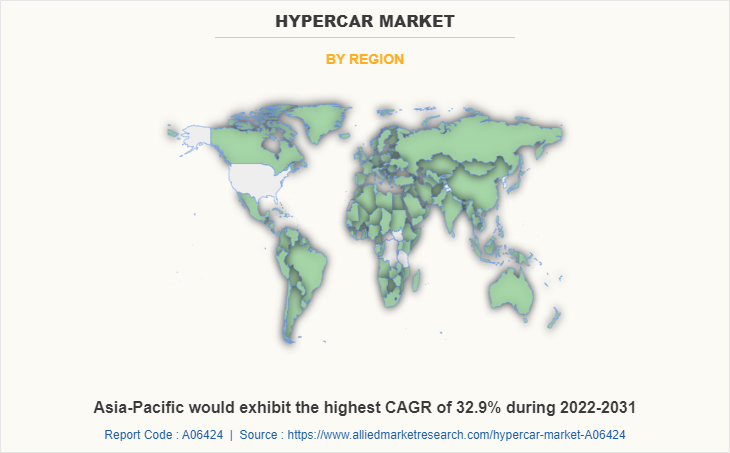Hypercar Market Overview
The global hypercar market was valued at USD 15.2 billion in 2021, and is projected to reach USD 224.5 billion by 2031, growing at a CAGR of 31.1% from 2022 to 2031. The growth of the global hypercar market is propelling, due to growth in demand for luxurious and comfortable driving experience. However, high cost of hypercars is the factor hampering the growth of the market. Furthermore, production of electric hypercars is the factor expected to offer growth opportunities during the forecast period.
Key Market Trends & Insights
- Battery electric segment is expected to show significant growth in the near future.
- Racing segment is projected to exhibit strong growth during the forecast period.
- Asia-Pacific is anticipated to register the highest CAGR in the coming years.
Market Size & Forecast
- 2031 Projected Market Size: USD 224.5 billion
- 2021 Market Size: USD 15.2 billion
- Compound Annual Growth Rate (CAGR) (2022-2031): 31.1%

Introduction
A hypercar is an ultra-performance supercar, which allows excellent driving performance. A hypercar is composed of aerodynamic design, low drag body, and ultra-lightweight components. In addition, a hypercar has 800+ horsepower, a 0-60 speed under 3 seconds, and a top speed ranging from 215 mph to 270 mph. Moreover, vast majority of hypercars are limited-production, which means they are produced in a limited quantity ranging within 1 to 1000. Furthermore, some popular hypercars comprise Pagani Huayra, McLaren P1, Ferrari LaFerrari, Porsche 918 Spyder, and others.
Increasing global disposable income and growing automobile industry are anticipated to propel the growth of hypercar market. In addition, as the luxury car manufacturers are planning to shift from gas to electric in the coming years, development of ICE-based hypercars is expected to decrease. However, few manufacturers are still launching ICE-based hypercar in the market, which fuels the growth of the segment in the hypercar industry. For instance, in November 2021, Ferrari unveiled the Daytona SP3 hypercar. The Daytona SP3 will be limited to 599 units and will retail in Italy for $2.2 million. The new hypercar comprises a naturally aspirated V12 engine, which produces 697 nm of torque. It also claims a 0-100 kmph time of 2.5 seconds and a top speed of 340 kmph.
Market Segmentation
The hypercar market is segment on the basis of propulsion, end use, and region. By propulsion, it is segmented into ICE (internal combustion engine), battery electric, and hybrid. By end use, it is categorized into private and racing. By region, the report is analyzed across North America, Europe, Asia-Pacific, and LAMEA.
Which are the Top Hypercar companies
The following are the leading companies in the market. These players have adopted various strategies to increase their market penetration and strengthen their position in the hypercar industry.
- Aston Martin
- Audi AG
- Automobili Lamborghini S.P.A
- Bentley Motors
- BMW AG
- Bugatti Automobiles S.A.S
- Ferrari N.V.
- Horacio Pagani S.P.A
- Koenigsegg Automotive AB
- McLaren Group Limited
- Mercedes-Benz Group AG
- Porsche Automobil Holding SE

What are the Top Impacting Factors
Key Market Driver
Rise in demand for hypercars
There is an increasing popularity of hypercars in consumers as hypercars offer extreme performance in terms of power output, acceleration, and torque. In addition, rising automotive industry and increase in integration of advanced technology to improve driving performance of hypercars are contributing in rising the demand for hypercars. Moreover, hypercar manufacturers are utilizing hydrogen as an alternative to petrol and diesel, which is aiding in increasing vehicle speed and boosting the hypercars demand. Furthermore, integration of advanced technology, such as break steering four-wheel drive, active airbrakes, and others is propelling the demand for hypercars.
Rise in demand for luxurious and comfortable driving experience
Consumers are inclined toward comfort while driving due to increase in their purchasing power. Hypercars are majorly made by using latest technologies, advanced materials, and powerful engines. In addition, hypercars offer technologies, such as satellite radio, intelligent remote entry, and adaptive cruise control, which provide comfortable driving experience. Furthermore, features such as active suspension, executive rear seats, remote start, and massaging seats are provided in hypercars for enhanced comfortable driving experience. Thus, rise in demand for comfortable and luxurious driving experience is anticipated to propel the growth of the hypercar market.

Restraints
High cost of hypercars
Hypercars are significantly expensive as compared to traditional vehicles, owing to their advanced and luxurious features, such as superior quality parts and expensive material used in them. In addition, the cost of building a hypercar with luxury options and features is higher than building a car with generic features. Furthermore, as hypercars are sold in very low volumes, a good portion of the selling price goes toward covering its developmental costs, which, in turn, makes these types of vehicles even costlier. Thus, high cost of hypercars is anticipated to hinder the market growth.
Opportunity
Production of electric hypercars
The sales of electric hypercars is exhibiting remarkable growth, owing to stringent emission mandates by governments of various countries and rising need for fuel-efficient vehicles. As sales of electric vehicles is spiking, many leading automakers like Tesla are introducing new range of electric vehicles. In addition, leading luxury and high-end luxury & performance car brands, such as Mercedes-Benz, Porsche, Royce, and Bugatti announced release of their own electric hypercars along with other luxury electric vehicles to meet emission standards. For instance, in July 2019, Lotus unveiled the all-new electric hypercar, namely, Evija. Evija was be a limited-run model, with only 130 units being produced. It offered 70kWh battery, capable of being charged at up to 350kW and provide a range of 402 km. Thus, production of electric hypercars to meet stringent emission standards provides a remarkable growth opportunity for the players operating in the hypercar market.

Key Benefits for Stakeholders
- This report provides a quantitative analysis of the market segments, current trends, estimations, and dynamics of the hypercar market analysis from 2021 to 2031 to identify the prevailing hypercar market opportunities.
- The market research is offered along with information related to key drivers, restraints, and opportunities.
- Porter's five forces analysis highlights the potency of buyers and suppliers to enable stakeholders make profit-oriented business decisions and strengthen their supplier-buyer network.
- In-depth analysis of the hypercar market segmentation assists to determine the prevailing market opportunities.
- Major countries in each region are mapped according to their revenue contribution to the global market.
- Market player positioning facilitates benchmarking and provides a clear understanding of the present position of the market players.
- The report includes the analysis of the regional as well as global hypercar market trends, key players, market segments, application areas, and market growth strategies.
Hypercar Market Report Highlights
| Aspects | Details |
| Market Size By 2031 | USD 224.5 billion |
| Growth Rate | CAGR of 31.1% |
| Forecast period | 2021 - 2031 |
| Report Pages | 207 |
| By Propulsion |
|
| By End-Use |
|
| By Region |
|
| Key Market Players | Lotus Cars Limited, Bugatti Automobiles S.A.S., Bentley Motors Limited, Automobili Lamborghini S.p.A., McLaren Group, Koenigsegg Automotive AB, Ferrari N.V., Aston Martin Lagonda Global Holdings PLC, Bayerische Motoren Werke AG, Audi AG Aktiengesellschaft, h.c. F. Porsche AG, Pagani Automobili S.p.A. |
Analyst Review
The global hypercar market is propelling, due to growth in demand for luxurious and comfortable driving experience. However, high cost of hypercars hampers the growth of the market.
Luxury car manufacturers are increasingly shifting from gas to electric in the coming years, which, in turn, is anticipated to create remarkable opportunities for players operating in the market. For instance, Lamborghini, offers new electric hypercars alongside internal combustion models, depending on consumer demand across the globe.
In addition, several companies operating in the hypercar market are launching new electric hypercar in the market, which fuels the growth of the market. For instance, in March 2019, Automobili Pininfarina unveiled its new electric hypercar Battista at Geneva Motor Show. The new car has 1900 Bhp and 2300 nm torque. It has the potential to accelerate to 62 mph in less than two seconds, which is faster than a Formula 1 car.
Key players operating in the market include Aston Martin, Audi AG, Automobili Lamborghini S.p.A, Bentley Motors, BMW AG, Bugatti Automobiles S.A.S., Ferrari N.V., Horacio Pagani S.P.A., Koenigsegg Automotive AB, McLaren Group, Mercedes-Benz Group AG, and Porsche Automobil Holding SE.
The global hypercar market was valued at $15.2 billion in 2021 and is projected to reach $224.5 billion in 2031, registering a CAGR of 31.1%.
The leading players in the market are Aston Martin, Audi AG, Automobili Lamborghini S.P.A, Bentley Motors, BMW AG, Bugatti Automobiles S.A.S, Ferrari N.V., Horacio Pagani S.P.A, Koenigsegg Automotive AB, Mclaren Group Limited, Mercedes-Benz Group AG, and Porsche Automobil Holding SE..
The largest regional market is Europe.
The leading application is private use.
The upcoming treand include greater adoption of electric vehicles, and rising use of hypercars in racing competitions.
Loading Table Of Content...



